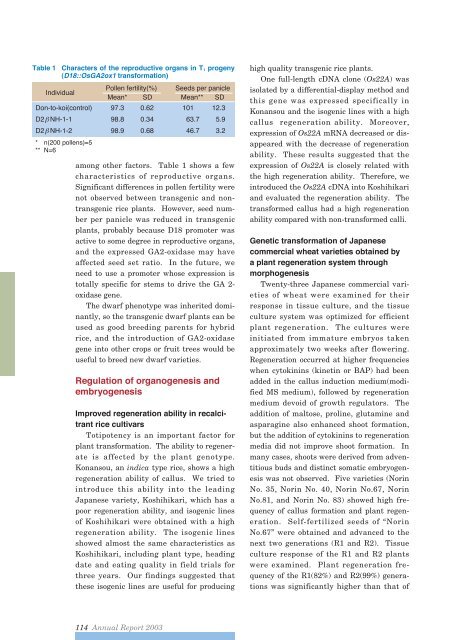You also want an ePaper? Increase the reach of your titles
YUMPU automatically turns print PDFs into web optimized ePapers that Google loves.
Table 1 Characters of the reproductive organs in T 1 progeny(D18::OsGA2ox1 transformation)IndividualPollen fertility(%) Seeds per panicleMean* SD Mean** SDDon-to-koi(control) 97.3 0.62 101 12.3D2 NH-1-1 98.8 0.34 63.7 5.9D2 NH-1-2 98.9 0.68 46.7 3.2* n(200 pollens)=5** N=6among other factors. Table 1 shows a fewcharacteristics of reproductive organs.Significant differences in pollen fertility werenot observed between transgenic and nontransgenicrice plants. However, seed numberper panicle was reduced in transgenicplants, probably because D18 promoter wasactive to some degree in reproductive organs,and the expressed GA2-oxidase may haveaffected seed set ratio. In the future, weneed to use a promoter whose expression istotally specific for stems to drive the GA 2-oxidase gene.The dwarf phenotype was inherited dominantly,so the transgenic dwarf plants can beused as good breeding parents for hybridrice, and the introduction of GA2-oxidasegene into other crops or fruit trees would beuseful to breed new dwarf varieties.Regulation of organogenesis andembryogenesisImproved regeneration ability in recalcitrantrice cultivarsTotipotency is an important factor forplant transformation. The ability to regenerateis affected by the plant genotype.Konansou, an indica type rice, shows a highregeneration ability of callus. We tried tointroduce this ability into the leadingJapanese variety, Koshihikari, which has apoor regeneration ability, and isogenic linesof Koshihikari were obtained with a highregeneration ability. The isogenic linesshowed almost the same characteristics asKoshihikari, including plant type, headingdate and eating quality in field trials forthree years. Our findings suggested thatthese isogenic lines are useful for producinghigh quality transgenic rice plants.One full-length cDNA clone (Os22A) wasisolated by a differential-display method andthis gene was expressed specifically inKonansou and the isogenic lines with a highcallus regeneration ability. Moreover,expression of Os22A mRNA decreased or disappearedwith the decrease of regenerationability. These results suggested that theexpression of Os22A is closely related withthe high regeneration ability. Therefore, weintroduced the Os22A cDNA into Koshihikariand evaluated the regeneration ability. Thetransformed callus had a high regenerationability compared with non-transformed calli.Genetic transformation of Japanesecommercial wheat varieties obtained bya plant regeneration system throughmorphogenesisTwenty-three Japanese commercial varietiesof wheat were examined for theirresponse in tissue culture, and the tissueculture system was optimized for efficientplant regeneration. The cultures wereinitiated from immature embryos takenapproximately two weeks after flowering.Regeneration occurred at higher frequencieswhen cytokinins (kinetin or BAP) had beenadded in the callus induction medium(modifiedMS medium), followed by regenerationmedium devoid of growth regulators. Theaddition of maltose, proline, glutamine andasparagine also enhanced shoot formation,but the addition of cytokinins to regenerationmedia did not improve shoot formation. Inmany cases, shoots were derived from adventitiousbuds and distinct somatic embryogenesiswas not observed. Five varieties (NorinNo. 35, Norin No. 40, Norin No.67, NorinNo.81, and Norin No. 83) showed high frequencyof callus formation and plant regeneration.Self-fertilized seeds of “NorinNo.67” were obtained and advanced to thenext two generations (R1 and R2). Tissueculture response of the R1 and R2 plantswere examined. Plant regeneration frequencyof the R1(82%) and R2(99%) generationswas significantly higher than that of114 <strong>Annual</strong> <strong>Report</strong> <strong>2003</strong>













